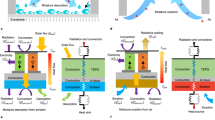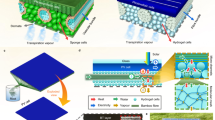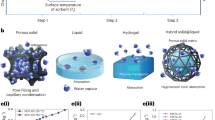Abstract
More than 600 GW of photovoltaic panels are currently installed worldwide, with the predicted total capacity increasing very rapidly every year. One essential issue in photovoltaic conversion is the massive heat generation of photovoltaic panels under sunlight, which represents 75–96% of the total absorbed solar energy and thus greatly increases the temperature and decreases the energy efficiency and lifetime of photovoltaic panels. In this report we demonstrate a new and versatile photovoltaic panel cooling strategy that employs a sorption-based atmospheric water harvester as an effective cooling component. The atmospheric water harvester photovoltaic cooling system provides an average cooling power of 295 W m–2 and lowers the temperature of a photovoltaic panel by at least 10 °C under 1.0 kW m–2 solar irradiation in laboratory conditions. It delivered a 13–19% increase in electricity generation in a commercial photovoltaic panel in outdoor field tests conducted in the winter and summer in Saudi Arabia. The atmospheric water harvester based photovoltaic panel cooling strategy has little geographical constraint in terms of its application and has the potential to improve the electricity production of existing and future photovoltaic plants, which can be directly translated into less CO2 emission or less land occupation by photovoltaic panels. As solar power is taking centre stage in the global fight against climate change, atmospheric water harvester based cooling represents an important step toward sustainability.
This is a preview of subscription content, access via your institution
Access options
Access Nature and 54 other Nature Portfolio journals
Get Nature+, our best-value online-access subscription
$29.99 / 30 days
cancel any time
Subscribe to this journal
Receive 12 digital issues and online access to articles
$119.00 per year
only $9.92 per issue
Buy this article
- Purchase on Springer Link
- Instant access to full article PDF
Prices may be subject to local taxes which are calculated during checkout






Similar content being viewed by others
Data availability
The data that support the findings of this study are available from the corresponding author on reasonable request.
References
Parida, B., Iniyan, S. & Goic, R. A review of solar photovoltaic technologies. Renew. Sustain. Energy Rev. 15, 1625–1636 (2011).
Yoshikawa, K. et al. Silicon heterojunction solar cell with interdigitated back contacts for a photoconversion efficiency over 26%. Nat. Energy 2, 17032 (2017).
Jäger-Waldau, A. PV Status Report 2019 (Publications Office, European Union, 2019).
Yang, D. & Yin, H. Energy conversion efficiency of a novel hybrid solar system for photovoltaic, thermoelectric, and heat utilization. IEEE Trans. Energy Conver. 26, 662–670 (2011).
van Helden, W. G. J., van Zolingen, R. J. C. & Zondag, H. A. PV thermal systems: PV panels supplying renewable electricity and heat. Prog. Photovolt. Res. Appl. 12, 415–426 (2004).
Makki, A., Omer, S. & Sabir, H. Advancements in hybrid photovoltaic systems for enhanced solar cells performance. Renew. Sustain. Energy Rev. 41, 658–684 (2015).
Natarajan, S. K., Mallick, T. K., Katz, M. & Weingaertner, S. Numerical investigations of solar cell temperature for photovoltaic concentrator system with and without passive cooling arrangements. Int. J. Therm. Sci. 50, 2514–2521 (2011).
Menke, S. M., Ran, N. A., Bazan, G. C. & Friend, R. H. Understanding energy loss in organic solar cells: toward a new efficiency regime. Joule 2, 25–35 (2018).
Skoplaki, E. & Palyvos, J. A. On the temperature dependence of photovoltaic module electrical performance: a review of efficiency/power correlations. Sol. Energy 83, 614–624 (2009).
Bredemeier, D., Walter, D., Herlufsen, S. & Schmidt, J. Lifetime degradation and regeneration in multicrystalline silicon under illumination at elevated temperature. AIP Adv. 6, 035119 (2016).
Jordan, D. C. & Kurtz, S. R. Photovoltaic degradation rates—an analytical review. Prog. Photovolt. Res. Appl. 21, 12–29 (2013).
Bahaidarah, H. M. S., Baloch, A. A. B. & Gandhidasan, P. Uniform cooling of photovoltaic panels: a review. Renew. Sustain. Energy Rev. 57, 1520–1544 (2016).
Siecker, J., Kusakana, K. & Numbi, B. P. A review of solar photovoltaic systems cooling technologies. Renew. Sustain. Energy Rev. 79, 192–203 (2017).
Shukla, A., Kant, K., Sharma, A. & Biwole, P. H. Cooling methodologies of photovoltaic module for enhancing electrical efficiency: a review. Sol. Energy Mater. Sol. Cells 160, 275–286 (2017).
Teo, H. G., Lee, P. S. & Hawlader, M. N. A. An active cooling system for photovoltaic modules. Appl. Energy 90, 309–315 (2012).
Nižetić, S., Čoko, D., Yadav, A. & Grubišić-Čabo, F. Water spray cooling technique applied on a photovoltaic panel: the performance response. Energy Convers. Manag. 108, 287–296 (2016).
Odeh, S. & Behnia, M. Improving photovoltaic module efficiency using water cooling. Heat Transf. Eng. 30, 499–505 (2009).
Nižetić, S., Giama, E. & Papadopoulos, A. M. Comprehensive analysis and general economic-environmental evaluation of cooling techniques for photovoltaic panels, part II: active cooling techniques. Energy Convers. Manag. 155, 301–323 (2018).
Bahaidarah, H., Subhan, A., Gandhidasan, P. & Rehman, S. Performance evaluation of a PV (photovoltaic) module by back surface water cooling for hot climatic conditions. Energy 59, 445–453 (2013).
Stropnik, R. & Stritih, U. Increasing the efficiency of PV panel with the use of PCM. Renew. Energy 97, 671–679 (2016).
Chandel, S. S. & Agarwal, T. Review of cooling techniques using phase change materials for enhancing efficiency of photovoltaic power systems. Renew. Sustain. Energy Rev. 73, 1342–1351 (2017).
Raman, A. P., Anoma, M. A., Zhu, L., Rephaeli, E. & Fan, S. Passive radiative cooling below ambient air temperature under direct sunlight. Nature 515, 540–544 (2014).
Zhu, L., Raman, A., Wang, K. X., Anoma, M. A. & Fan, S. Radiative cooling of solar cells. Optica 1, 32–38 (2014).
Popovici, C. G., Hudişteanu, S. V., Mateescu, T. D. & Cherecheş, N.-C. Efficiency improvement of photovoltaic panels by using air cooled heat sinks. Energy Procedia 85, 425–432 (2016).
Cuce, E., Bali, T. & Sekucoglu, S. A. Effects of passive cooling on performance of silicon photovoltaic cells. Int. J. Low-Carbon Technol. 6, 299–308 (2011).
Nižetić, S., Papadopoulos, A. M. & Giama, E. Comprehensive analysis and general economic-environmental evaluation of cooling techniques for photovoltaic panels, part I: passive cooling techniques. Energy Convers. Manag. 149, 334–354 (2017).
Kim, H. et al. Water harvesting from air with metal-organic frameworks powered by natural sunlight. Science 356, 430–434 (2017).
Kim, H. et al. Adsorption-based atmospheric water harvesting device for arid climates. Nat. Commun. 9, 1191 (2018).
Li, R. et al. Hybrid hydrogel with high water vapor harvesting capacity for deployable solar-driven atmospheric water generaRaman, A. P., Anoma, M. A., Zhu, L., Rephaeli, E. & Fan, S. Passive radiative cooling below ambient air temperature under direct sunlight. Nature 515,540–544 (2014tor. Environ. Sci. Technol. 52, 11367–11377 (2018).
Li, R., Shi, Y., Shi, L., Alsaedi, M. & Wang, P. Harvesting water from air: using anhydrous salt with sunlight. Environ. Sci. Technol. 52, 5398–5406 (2018).
Chan, H.-Y., Riffat, S. B. & Zhu, J. Review of passive solar heating and cooling technologies. Renew. Sustain. Energy Rev. 14, 781–789 (2010).
Mizuno, K. et al. A black body absorber from vertically aligned single-walled carbon nanotubes. Proc. Natl Acad. Sci. USA 106, 6044–6047 (2009).
Zeyghami, M., Goswami, D. Y. & Stefanakos, E. A review of clear sky radiative cooling developments and applications in renewable power systems and passive building cooling. Sol. Energy Mater Sol. Cells 178, 115–128 (2018).
Kandilli, C. & Ulgen, K. Solar illumination and estimating daylight availability of global solar irradiance. Energy Sources A 30, 1127–1140 (2008).
Zell, E. et al. Assessment of solar radiation resources in Saudi Arabia. Sol. Energy 119, 422–438 (2015).
UV Index: Diurnal Variability (NOAA / National Weather Service, Climate Prediction Center, 2020); https://go.nature.com/2yKKbby
Adinoyi, M. J. & Said, S. A. M. Effect of dust accumulation on the power outputs of solar photovoltaic modules. Renew. Energy 60, 633–636 (2013).
Mekonnen, M. M. & Hoekstra, A. Y. Four billion people facing severe water scarcity. Sci. Adv. 2, e1500323 (2016).
Montgomery, M. A. & Elimelech, M. Water and sanitation in developing countries: including health in the equation. Environ. Sci. Technol. 41, 17–24 (2007).
Schiermeier, Q. Water risk as world warms. Nature 505, 10–11 (2014).
Atlas of the Biosphere (Center for Sustainability and the Global Environment, University of Wisconsin-Madison, 2020); https://go.nature.com/2VHwe7g
Acknowledgements
This work was supported by the King Abdullah University of Science and Technology (KAUST) Center Competitive Fund (CCF), awarded to the Water Desalination and Reuse Center (WDRC).
Author information
Authors and Affiliations
Contributions
P.W. supervised the project; R.L., Y.S. and P.W. conceived the idea and designed the experiments; R.L. and M.W. conducted the materials synthesis, characterization and performance investigation; S.H. produced the graphics; R.L. and P.W. co-wrote the paper. All the authors discussed and commented on the manuscript.
Corresponding author
Ethics declarations
Competing interests
P.W., R.L. and Y.S. have a patent application related to the work presented in this paper (U.S. Application No. 62/767,646).
Additional information
Publisher’s note Springer Nature remains neutral with regard to jurisdictional claims in published maps and institutional affiliations.
Supplementary information
Supplementary Information
Supplementary Figs. 1–18, Notes 1–3 and Tables 1–3.
Rights and permissions
About this article
Cite this article
Li, R., Shi, Y., Wu, M. et al. Photovoltaic panel cooling by atmospheric water sorption–evaporation cycle. Nat Sustain 3, 636–643 (2020). https://doi.org/10.1038/s41893-020-0535-4
Received:
Accepted:
Published:
Issue Date:
DOI: https://doi.org/10.1038/s41893-020-0535-4
This article is cited by
-
Sustainable moisture energy
Nature Reviews Materials (2024)
-
Passive interfacial cooling-induced sustainable electricity–water cogeneration
Nature Water (2024)
-
Self-recovering passive cooling utilizing endothermic reaction of NH4NO3/H2O driven by water sorption for photovoltaic cell
Nature Communications (2023)
-
Sorbents, processes and applications beyond water production in sorption-based atmospheric water harvesting
Nature Water (2023)
-
Fresh water from thin air
Nature (2023)



